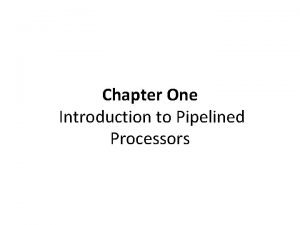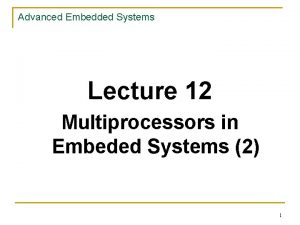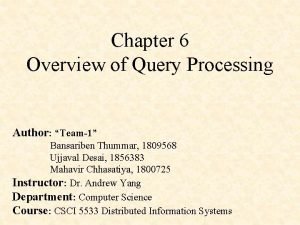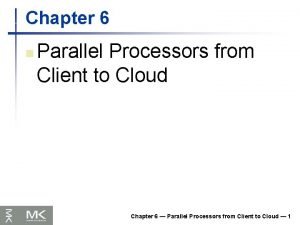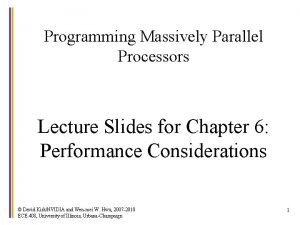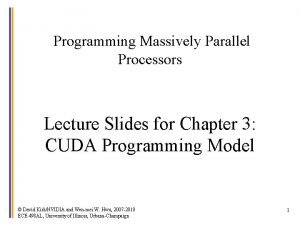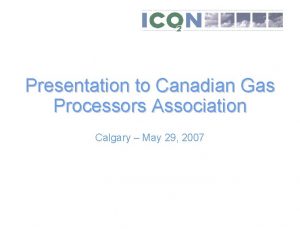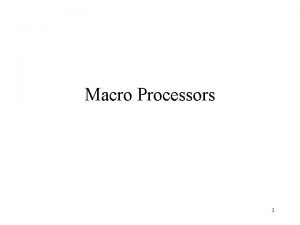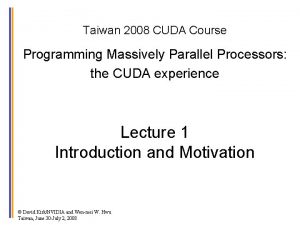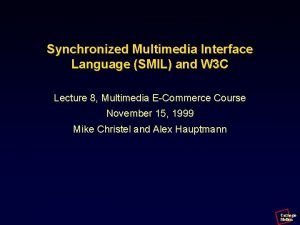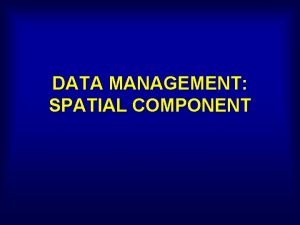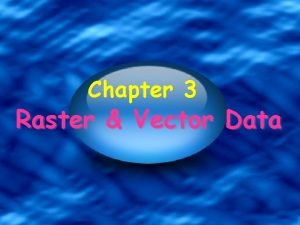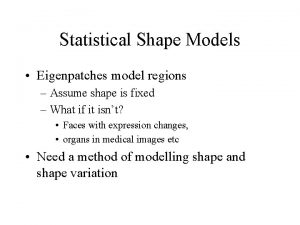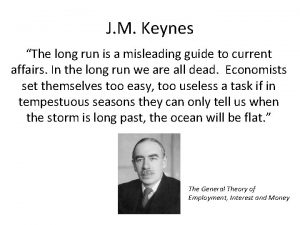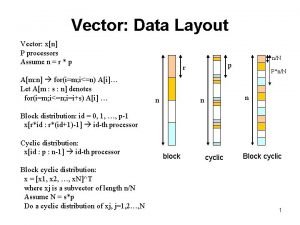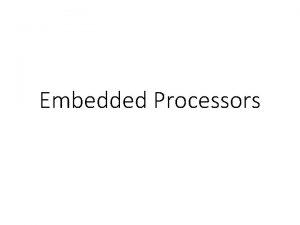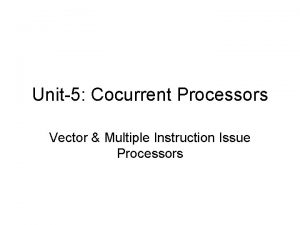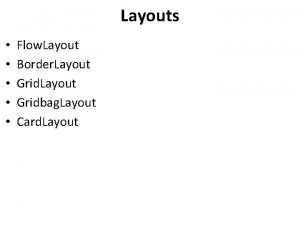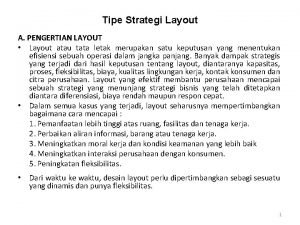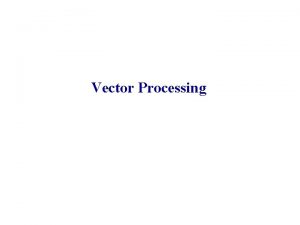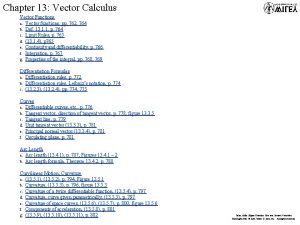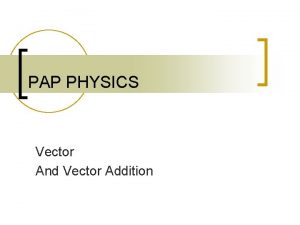Vector Data Layout Vector xn P processors Assume
![Vector: Data Layout Vector: x[n] P processors Assume n = r * p A[m: Vector: Data Layout Vector: x[n] P processors Assume n = r * p A[m:](https://slidetodoc.com/presentation_image_h2/012617cd0dcb0137f6e3a5f4eebc5894/image-1.jpg)










![Matrix Multiplication Row: A(i, : ) = [Ai 1, Ai 2, …, Ain] Column: Matrix Multiplication Row: A(i, : ) = [Ai 1, Ai 2, …, Ain] Column:](https://slidetodoc.com/presentation_image_h2/012617cd0dcb0137f6e3a5f4eebc5894/image-12.jpg)




























- Slides: 40
![Vector Data Layout Vector xn P processors Assume n r p Am Vector: Data Layout Vector: x[n] P processors Assume n = r * p A[m:](https://slidetodoc.com/presentation_image_h2/012617cd0dcb0137f6e3a5f4eebc5894/image-1.jpg)
Vector: Data Layout Vector: x[n] P processors Assume n = r * p A[m: n] for(i=m; i<=n) A[i]… Let A[m : s : n] denotes for(i=m; i<=n; i=i+s) A[i] … p r n n/N P*n/N n n Block distribution: id = 0, 1, …, p-1 x[r*id : r*(id+1)-1] id-th processor Cyclic distribution: x[id : p : n-1] id-th processor Block cyclic distribution: x = [x 1, x 2, …, x. N]^T where xj is a subvector of length n/N Assume N = s*p Do a cyclic distribution of xj, j=1, 2…, N block cyclic Block cyclic 1

Matrix: Data Layout Row: block, cyclic, block cyclic Column: block, cyclic, block cyclic Matrix: 9 combinations If only one block in one direction 1 D decomposition Otherwise 2 D decomposition 1 D block cyclic e. g. p processors with a (Nx, Ny) virtual topology, p=Nx*Ny Matrix A[n][n], n = rx * Nx = ry * Ny A[rx*I : rx*(I+1)-1, J: Ny: n-1], I=0, …, rx-1, J=0, …, ry-1, is a 2 D decomposition, block distribution in x direction, cyclic distribution in y direction 2 D block cyclic 2

Matrix-Vector Multiply: Row-wise A cpu 0 A 11 A 12 cpu 1 A 22 A 13 A 23 X Y X 1 Y 1 X 2 = Y 2 X 3 Y 3 X 2 Y 1 cpu 2 A 31 A 32 cpu 0 A 11 A 12 cpu 1 A 22 A 23 X 3 = Y 2 cpu 2 A 31 A 32 A 33 X 1 Y 3 cpu 0 A 11 A 12 X 3 Y 1 A 33 A 13 cpu 1 A 22 A 23 X 1 = cpu 2 A 31 A 32 A 33 X 2 Y 3 AX=Y A – Nx. N matrix, row-wise block distribution X, Y – vectors, dimension N Y 1 = A 11*X 1 + A 12*X 2 + A 13*X 3 Y 2 = A 21*X 1 + A 22*X 2 + A 23*X 3 Y 3 = A 31*X 1 + A 32*X 2 + A 33*X 3 3

Matrix-Vector Multiply: Column-wise A cpu 0 A 11 A 12 cpu 1 A 22 A 13 A 23 X Y X 1 Y 1 X 2 = Y 2 X 3 Y 3 X 1 Y 2 cpu 2 A 31 A 32 cpu 0 A 11 A 12 cpu 1 A 22 A 23 X 2 = Y 3 cpu 2 A 31 A 32 A 33 X 3 Y 1 cpu 0 A 11 A 12 X 1 Y 3 A 33 A 13 cpu 1 A 22 A 23 X 2 = cpu 2 A 31 A 32 X 3 A 33 Y 1 Y 2 AX=Y A – Nx. N matrix, column-wise block distribution X, Y – vectors, dimension N Y 1 = A 11*X 1 + A 12*X 2 + A 13*X 3 Y 2 = A 21*X 1 + A 22*X 2 + A 23*X 3 Y 3 = A 31*X 1 + A 32*X 2 + A 33*X 3 Y 1 = A 11*X 1 + A 12*X 2 + A 13*X 3 Y 2 = A 21*X 1 + A 22*X 2 + A 23*X 3 4

Matrix-Vector Multiply: Row-wise All-gather 5

Matrix-Vector Multiply: Column-wise A X Y X 1 Y 1 cpu 0 A 11 A 12 cpu 1 A 22 A 23 X 2 = Y 2 cpu 2 A 31 A 32 A 33 X 3 Y 3 A 13 AX=Y A – Nx. N matrix, column-wise block distribution X, Y – vectors, dimension N First local computations Y 1’ = A 11*X 1 Y 2’ = A 21*X 1 Y 3’ = A 31*X 1 Y 1’ = A 12*X 2 Y 2’ = A 22*X 2 Y 3’ = A 32*X 2 Y 1’ = A 13*X 3 Y 2’ = A 23*X 3 Y 3’ = A 33*X 3 Then reduce-scatter across processors 6

Matrix-Vector Multiply: 2 D Decomposition x A P_{0} P_{1} … P_{K-1} P_{K+1} … P_{2 K-1} Each block of A is distributed to a cpu X is distributed to the K cpus in last column … … P=K^2 number of cpus As a 2 D Kx. K mesh A – K x K block matrix, each block (N/K)x(N/K) X – K x 1 blocks, each block (N/K)x 1 … Result A*X be distributed on the K cpus of the last column 7

Matrix-Vector Multiply: 2 D Decomposition 8

Homework q Write an MPI program and implement the matrix vector multiplication algorithm with 2 D decomposition q Assume: v Y=A*X, A – Nx. N matrix, X – vector of length N v Number of processors P=K^2, arranged as a K x K mesh in a row-major fashion, i. e. cpus 0, …, K-1 in first row, K, …, 2 K-1 in 2 nd row, etc v N can be divided by K. v Initially, each cpu has the data for its own submatrix of A; Input vector X is distributed on processors of the rightmost column, i. e. cpus K-1, 2 K-1, …, P-1 q In the end, the result vector Y should be distributed on processors at the rightmost column. q A[i][j] = 2*i+j, X[i] = i; q Make sure your result is correct using a small value of N q Turn in: v Source code + binary v Wall-time and speedup vs. cpu for 1, 4, 16 processors for N = 1024. 9

Load Balancing: (Block) Cyclic y 1 a y 2 a a y 3 a a a y 4 b b b b b y 6 b b b y 7 c c c c y 8 c c c c y 9 c c c c y 1 a y 4 a b b b y 7 c c a a y 5 b b b y 8 c c c y 3 a a a y 6 b b b y 9 c c c y 5 y 2 = = x 1 x 2 x 3 x 4 x 5 x 6 x 7 x 8 c x 9 x 1 x 2 c c c x 3 x 4 x 5 c c c x 6 x 7 x 8 c c c x 9 10

Cyclic Distribution r = n/p for t=0: p-1 send(xloc, left) s = (id+t)%p // xloc = x(s*r: (s+1)*r-1) for i=0: r-1 for j=0: min(id+i*p-s*r, r) yloc(j) += Aloc(i, j+s*r)*xloc(j) end recv(xloc, right) end Matrix-vector multiply, row-wise cyclic distribution of A and y Block distribution of x Initial data: id – cpu id p – number of cpus ids of left/right neighbors n – matrix dimension, n=r*p Aloc = A(id: p: n-1, : ) yloc = y(id: p: n-1) xloc = x(id*r: (id+1)*r-1) 11
![Matrix Multiplication Row Ai Ai 1 Ai 2 Ain Column Matrix Multiplication Row: A(i, : ) = [Ai 1, Ai 2, …, Ain] Column:](https://slidetodoc.com/presentation_image_h2/012617cd0dcb0137f6e3a5f4eebc5894/image-12.jpg)
Matrix Multiplication Row: A(i, : ) = [Ai 1, Ai 2, …, Ain] Column: A(: , j) = [A 1 j, A 2 j, …, Anj]^T Submatrix: A(i 1: i 2, j 1: j 2) = [ A(i, j) ], i 1<=i<=i 2, j 1<=j<=j 2 for i=1: m for j=1: n for k=1: p C(i, j) = C(i, j)+A(i, k)*B(k, j) end end for i=1: m for j=1: n C(i, j) = C(i, j)+A(i, : )B(: , j) end A–mxp B–pxn C–mxn C = AB + C (ijk) variant of matrix multiplication Dot product formulation A(i, : ) dot B(: , j) A accessed by row B accessed by column Non-optimal memory access! 12

Matrix Multiply ijk loop can be arranged in other orders (ikj) variant for i=1: m for k=1: p for j=1: n C(i, j) = C(i, j) + A(i, k)B(k, j) end end axpy formulation B by row C by row for i=1: m for k=1: p C(i, : ) = C(i, : ) + A(i, k)B(k, : ) end (jki) variant for j=1: n for k=1: p for i=1: m C(i, j) = C(i, j)+A(i, k)B(k, j) end end for j=1: n for k=1: p C(: , j) = C(: , j)+A(: , k)B(k, j) end axpy formulation A by column C by column 13

Other Variants Loop order Inner loop Middle loop Inner loop data access ijk Dot Axpy A by row, B by column jik Dot Axpy A by row, B by column ikj axpy Axpy B by row, C by row jki axpy A by column, C by column kij axpy Row outer product B by row, C by row kji axpy Column outer product A by column, C by column 14

Block Matrices Block matrix multiply A, B, C – Nx. N block matrices each block: s x s (mnp) variant also other variants for m=1: N for n = 1: N for p = 1: N i=(m-1)s+1 : ms j = (n-1)s+1 : ns k = (p-1)s+1 : ps C(i, j) = C(i, j) + A(i, k)B(k, j) end end Cache blocking 15

Block Matrices 16

Matrix Multiply: Column-wise A A 1 A 2 C B A 3 B 11 B 12 B 13 B 21 B 22 B 23 B 31 B 32 B 33 C 1 = A 1*B 11 + A 2*B 21 + A 3*B 31 cpu 0 C 2 = A 1*B 12 + A 2*B 22 + A 3*B 32 cpu 1 C 3 = A 1*B 13 + A 2*B 23 + A 3*B 33 cpu 2 = C 1 C 2 C 3 A, B, C – Nx. N matrices P – number of processors A 1, A 2, A 3 – Nx(N/P) matrices C 1, C 2, C 3 - … Bij – (N/P)x(N/P) matrices Column-wise decomposition 17

Matrix Multiply: Row-wise A 11 A 12 A 13 B 1 A 22 A 23 B 2 A 31 A 32 A 33 B 3 C 1 = A 11*B 1 + A 12*B 2 + A 13*B 3 cpu 0 C 2 = A 21*B 1 + A 22*B 2 + A 23*B 3 cpu 1 C 3 = A 31*B 1 + A 32*B 2 + A 33*B 3 cpu 2 C 1 = C 2 C 3 A, B, C – Nx. N matrices P – number of processors B 1, B 2, B 3 – (N/P)x. N matrices C 1, C 2, C 3 - … Aij – (N/P)x(N/P) matrices 18

Matrix Multiply: 2 D Decomposition Hypercube-Ring broadcast Step 1 Broadcast A diagonals Shift B C fixed Step 2 shift Cpus: P = K^2 Matrices A, B, C: dimension N x N, K x K blocks Each block: (N/K) x (N/K) Determine coordinate (irow, icol) of current cpu. Set B’=B_local For j=0: K-1 root_col = (irow+j)%K broadcast A’=A_local from root cpu (irow, root_col) to other cpus in the row C_local += A_local*B_local shift B’ upward one step end A 01 A 12 A 23 A 30 Step 2 19

Matrix Multiply q. Total ~K*log(K) communication steps, or sqrt(P)log(sqrt(P)) steps v. In contrast, 1 D decomposition, P communication steps q. Can use max N^2 processors for problem size Nx. N matrices v 1 D decomposition, max N processors 20

Matrix Multiply: Ring-Hypercube A 00 A 01 A 02 A 03 A 10 A 11 A 12 A 13 A 20 A 21 A 22 A 23 Determine coordinate (irow, icol) of current cpu. Set A’=A_local For j=0: K-1 root_row = (icol+j)%K broadcast B’=B_local from root cpu (root_row, icol) to other cpus in the column C_local += A_local*B_local Shift A’ leftward one step end A 30 A 31 A 32 A 33 Number of cpus: P=K^2 A, B, C: K x K block matrices each block: (N/K) x (N/K) B 00 B 11 B 22 B 33 Shift A columns Broadcast B diag C fixed Step 1 Step 2 A 00 B 00 A 01 B 11 A 02 B 22 A 03 B 33 A 01 B 10 A 02 B 21 A 03 B 32 A 00 B 03 A 10 B 00 A 11 B 11 A 12 B 22 A 13 B 33 A 11 B 10 A 12 B 21 A 13 B 32 A 10 B 03 A 20 B 00 A 21 B 11 A 22 B 22 A 23 B 33 A 21 B 10 A 22 B 21 A 23 B 32 A 20 B 03 A 30 B 00 A 31 B 11 A 32 B 22 A 33 B 33 A 31 B 10 A 32 B 21 A 33 B 32 A 30 B 03 21

A 00 B 00 A 01 B 01 A 02 B 02 A 03 B 03 A 00 B 00 A 01 B 11 A 02 B 22 A 03 B 33 A 01 A 02 A 03 A 00 A 10 B 10 A 11 B 11 A 12 B 12 A 13 B 13 A 10 B 00 A 11 B 11 A 12 B 22 A 13 B 33 A 11 A 12 A 13 A 10 A 20 B 20 A 21 B 21 A 22 B 22 A 23 B 23 A 20 B 00 A 21 B 11 A 22 B 22 A 23 B 33 A 21 A 22 A 23 A 20 A 30 B 30 A 31 B 31 A 32 B 32 A 33 B 33 A 30 B 00 A 31 B 11 A 32 B 22 A 33 B 33 A 31 A 32 A 33 A 30 initial Broadcast B compute Shift A broadcast B A 01 B 10 A 02 B 21 A 03 B 32 A 00 B 03 A 02 A 03 A 00 A 01 A 02 B 20 A 03 B 31 A 00 B 02 A 01 B 13 A 11 B 10 A 12 B 21 A 13 B 32 A 10 B 03 A 12 A 13 A 10 A 11 A 12 B 20 A 13 B 31 A 10 B 02 A 11 B 13 A 21 B 10 A 22 B 21 A 23 B 32 A 20 B 03 A 22 A 23 A 20 A 21 A 22 B 20 A 23 B 31 A 20 B 02 A 21 B 13 A 31 B 10 A 32 B 21 A 33 B 32 A 30 B 03 A 32 A 33 A 30 A 31 A 32 B 20 A 33 B 31 A 30 B 02 A 31 B 13 Matrix Multiply: Ring-Hypercube 22

Matrix Multiply: Systolic (Torus) A 00 B 00 A 01 B 01 A 02 B 02 C fixed A 10 B 10 A 11 B 11 A 12 B 12 A 20 B 20 A 21 B 21 A 22 B 22 Number of cpus: P=K^2 A, B, C: K x K block matrices each block: (N/K) x (N/K) B Shift rows of A leftward Shift columns of B upward initial Step 1 A Step 2 Step 3 A 00 B 00 A 01 B 11 A 02 B 22 A 01 B 10 A 02 B 21 A 00 B 02 A 02 B 20 A 00 B 01 A 01 B 12 A 11 B 10 A 12 B 21 A 10 B 02 A 12 B 20 A 10 B 01 A 11 B 12 A 10 B 00 A 11 B 11 A 12 B 22 A 22 B 20 A 20 B 01 A 21 B 12 A 20 B 00 A 21 B 11 A 22 B 22 A 21 B 10 A 22 B 21 A 20 B 02 23

Matrix Multiply: Systolic P = K^2 number of processors, as a K x K 2 D torus A, B, C: Kx. K block matrices, each block (N/K)x(N/K) Each cpu computes 1 block: A_loc, B_loc, C_loc Coordinate in torus of current cpu: (irow, icol) Ids of left, right, top, bottom neighboring processors // first get appropriate initial distribution for j=0: irow-1 send(A_loc, left); recv(A_loc, right) end for j=0: icol-1 send(B_loc, top); recv(B_loc, bottom) end // start computation Max N^2 processors for j=0: K-1 send(A_loc, left) ~ sqrt(P) communication steps send(B_loc, top) C_loc = C_loc + A_loc*B_loc recv(A_loc, right) recv(B_loc, bottom) end 24

Matrix Multiply on P=K^3 CPUs Assume: A, B, C: dimension N x N P = K^3 number of processors Organized into K x K 3 D mesh A (Nx. N) can be considered as a q x q block matrix, each block (N/q)x(N/q) Let q = K^(1/3), i. e. consider A as a K^(1/3) x K^(1/3) block matrix, each block being (N/K^(1/3)) x (N/K^(1/3)) Similar for B and C 25

Matrix Multiply on K^3 CPUs r, s = 1, 2, …, K^(1/3) Total K^(1/3)*K^(1/3) = K block matrix multiplications Idea: Perform these K matrix multiplications on the K different planes (or levels) of the 3 D mesh of processors. Processor (i, j, k) (i, j=1, …, K) belongs to plane k. Will perform multiplication A_{rt}*B_{ts}, where k = (r-1)*K^(2/3)+(s 1)*K^(1/3)+t Within a plane, (N/K^(1/3)) x (N/K^(1/3)) matrix multiply on K x K processors. Use the systolic multiplication algorithm. Within a plane k: A_{rt}, B_{ts} and C_{rs} decomposed into K x K block matrices, each block (N/K^(4/3)) x (N/K^(4/3)). 26

B_{ts} A_{rt} Matrix Multiply (i, j) N/K^(1/3) dimension A, B, C x On Kx. K processors A_{rt} destined to levels k=(r-1)*K^(2/3)+(s 1)K^(1/3)+t, for all s=1, …, K^(1/3) B_{ts} destined to levels k=(r-1)*K^(2/3)+(s 1)*K^(1/3)+t, for all r=1, …, K^(1/3) blocks Initially, processor (i, j, 1) has (i, j) sub-blocks of all A_{rt} and B_{ts} blocks, for all r, s, t=1, …, K^(1/3), i, j=1, …, K K blocks Initial data distribution 27

Matrix Multiply // set up input data On processor (i, j, 1), read in the (i, j)-th block of matrices A_{r, t} and B_{t, s}, 1<= r, s, t <= K^(1/3); pass data onto processor (i, j, 2); On processor (i, j, m), make own copy of A_{rt} if m=(r-1)*K^(2/3)+(s-1)*K^(1/3)+t for some s=1, . . . , K^(1/3); make own copy of B_{ts} if m=(r-1)*K^(2/3)+(s-1)*K^(1/3)+t for some r=1, . . . , K^(1/3); pass data onward to (i, j, m+1); // Computation On each processor (i, j, m), Compute A_{rt}*B_{ts} on the K x K processors using the systolic matrix multiplication algorithm; Some initial data setup may be needed before multiplication; // Summation Determine (r 0, s 0) of matrix the current processor (i, j, k) works on: r 0 = k/K^(2/3)+1; s 0 = (k-(r 0 -1)*K^(2/3))/K^(1/3); Do reduction (sum) over processors (i, j, m), m=(r 0 -1)*K^(2/3)+(s 0 -1)*K^(1/3)+t, of all 1<=t<=K^(1/3); 28

Matrix Multiply q. Communication steps: ~K, or P^(1/3) q. Maximum CPUs: N/K^(4/3) = 1 K=N^(3/4), or P=N^(9/4) 29

Matrix Multiply q If number of processors: P = KQ^2, arranged into Kx. Q mesh v. K planes v. Each plane Qx. Q processors q Handle similarly v. Decompose A, B, C into K^(1/3)x. K^(1/3) blocks v. Different block matrix multiplications in different planes, K multiplications total v. Each block multiplication handled in a plane on Qx. Q processors; use any favorable algorithm, e. g. systolic 30

Processor Array in Higher Dimension q Processors P=K^4, arranged into Kx. Kx. K mesh q Similar strategy: v. Divide A, B, C into K^(1/3)x. K^(1/3) block matrices v. Different multiplications (total K) computed on different levels of 1 st dimension v. Each block matrix multiplication done on the Kx. K mesh at one level; repeat the above strategy. q For even higher dimensions, P=K^n, n>4, handle similarly. 31

Matrix Multiply: DNS Algorithm Assume: A, B, C: dimension N x N P = K^3 number of processors Organized into K x K 3 D mesh A, B, C are K x K block matrices, each block (N/K) x (N/K) Total K*K*K block matrix multiplications Idea: each block matrix multiplication is assigned to one processor Processor (i, j, k) computes C_{ij}=A_{ik}*B_{kj} Need a reduction (sum) over processors (i, j, k), k=0, …, K-1 32

Matrix Multiply: DNS Algorithm Initial data distribution: A_{ij} and B_{ij} at processor (i, j, 0) Need to trasnsfer A_{ik} (i, k=0, …, K-1) to processor (i, j, k) for all j=0, 1, …, K-1 Two steps: - Send A_{ik} from processor (i, k, 0) to (i, k, k); - Broadcast A_{ik} from processor (i, k, k) to processors (i, j, k); 33

Matrix Multiply Send A_{ik} from (i, k, 0) to (i, k, k) To broadcast A_{ik} from (i, k, k) to (i, j, k) 34

Matrix Multiply Final data distribution for A A can also be considered to come in through the (i, k) plane; with a broadcast along the j-direction. 35

B Distribution B distribution: Initially B_{kj} in processor (k, j, 0); Need to transfer to processors (i, j, k) for all i=0, 1, …, K-1 Two steps: -First send B_{kj} from (k, j, 0) to (k, j, k) -Broadcast B_{kj} from (k, j, k) to (i, j, k) for all i=0, …, K-1, i. e. along i-direction 36

3, 3 3, 2 B Distribution 3, 1 3, 0 2, 3 2, 2 2, 1 2, 0 Send B_{kj} from (k, j, 0) to (k, j, k) 1, 3 1, 2 1, 1 To broadcast from (k, j, k) to along i direction 1, 0 k 0, 3 j 0, 2 0, 1 0, 0 37 i

Matrix Multiply Final B distribution: B can also be considered to come through (j, k) plane; then broadcast along i-direction 38

Matrix Multiply A_{ik} and B_{kj} on cpu (i, j, k) Compute C_{ij} locally Reduce (sum) C_{ij} along k-direction Final result: C_{ij} on cpu (i, j, 0) 39

Matrix Multiply A matrix comes through (i, k) plane, broadcast along j-direction B matrix comes through (j, k) plane, broadcast along i-direction C matrix result goes to (i, j) plane Broadcast: 2 log(K) steps Reduction: log(K) steps Total: 3 log(K) = log(P) steps Can use a maximum of P=N^3 processors In contrast: Systolic: P^(1/2) communication steps Can use a maximum of P=N^2 processors Slide #24: P^(1/3) communication steps Can use a maximum of P=N^(9/4) processors 40
 Programming massively parallel processors
Programming massively parallel processors Linear pipeline
Linear pipeline Interrupt handling in arm processors
Interrupt handling in arm processors Processor history
Processor history Handler's classification in parallel computing
Handler's classification in parallel computing Digital camera processors
Digital camera processors Intel processor weakness
Intel processor weakness Embeded processors
Embeded processors Embedded innovator winter 2010
Embedded innovator winter 2010 Comparison of word processors
Comparison of word processors Layers of query processing
Layers of query processing Parallel processors from client to cloud
Parallel processors from client to cloud Programming massively parallel processors
Programming massively parallel processors Massively parallel processing ppt
Massively parallel processing ppt Gas processors association
Gas processors association Gstreamer architecture
Gstreamer architecture Ece 526
Ece 526 Data structures used in macro processor
Data structures used in macro processor Vliw
Vliw Function of macro processor
Function of macro processor Language and processors for requirement
Language and processors for requirement Introduction of telecommunication
Introduction of telecommunication Programming massively parallel processors, kirk et al.
Programming massively parallel processors, kirk et al. Denominator layout
Denominator layout Smil head layout root-layout
Smil head layout root-layout Cddat
Cddat Fluid layout vs fixed layout
Fluid layout vs fixed layout Raster vs vector data
Raster vs vector data Vector data vs raster data
Vector data vs raster data Find a unit vector in the direction of the given vector.
Find a unit vector in the direction of the given vector. Vector unitario de un vector
Vector unitario de un vector Vector resolution examples
Vector resolution examples Define position vectors
Define position vectors Always assume positive intent
Always assume positive intent Assume shape
Assume shape Difference between manager and entrepreneur
Difference between manager and entrepreneur Origami spiny lobster
Origami spiny lobster Never assume always ask
Never assume always ask Assume that a firm produces output using one fixed input
Assume that a firm produces output using one fixed input Lsaiso
Lsaiso Assume the economy of andersonland
Assume the economy of andersonland




